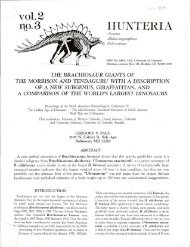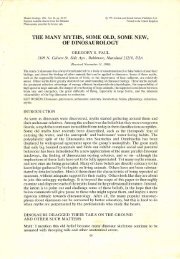Dinosaur models: the good, the bad, and using - Gregory S. Paul
Dinosaur models: the good, the bad, and using - Gregory S. Paul
Dinosaur models: the good, the bad, and using - Gregory S. Paul
Create successful ePaper yourself
Turn your PDF publications into a flip-book with our unique Google optimized e-Paper software.
FIGURE i-This log-log plot shows how actual or modeled body mass is correlated to <strong>the</strong> combined circumference of <strong>the</strong> humerus plus femur in<br />
large quadrupedal mammals (small case) <strong>and</strong> dinosaurs (capitals). The sloping line is <strong>the</strong> correlation calculated by Anderson et al. (1985); horizontal<br />
lines connect <strong>the</strong> actual or modeled mass of each specimen to <strong>the</strong> predicted value (example: <strong>the</strong> mass predicted for an elephant with a combined<br />
circumference of 872 mm is about 8 tonnes, but its actual mass is about 6 tonnes). Note that only one mammal actually falls on <strong>the</strong> line, o<strong>the</strong>r<br />
mammals are ei<strong>the</strong>r much lighter or heavier than predicted; <strong>the</strong> dashed horizontal line shows <strong>the</strong> two fold variation in body mass that can occur<br />
at any given circumference of limb bones in primarily terrestrial mammals (based on data in Anderson et al., 1985). Also indicated are <strong>the</strong> masses<br />
modeled by Colbert (1962, thick short vertical line) <strong>and</strong> Alex<strong>and</strong>er (1989, thinner short vertical line). Sauropods-A, Apatosaurus; B, Brachiosaurus<br />
African <strong>and</strong> American (upper); C, Camarasaurus adult <strong>and</strong> juvenile; D, Diplodocus; M, Amargasaurus; 0, Opisthocoelicaudia: stegosaurs=-J,<br />
Tuojiangosaurus; S, Stegosaurus: ankylosaurs-E, Euoplocephalus; R, Sauropelta: ceratopsids=-H, Chasmosaurus; N, Centrosaurus; T, Triceratops:<br />
mammals-b, bison; e, African elephant (Jumbo); g, giraffe; h, hippo; r; Indian rhino su<strong>bad</strong>ult; x, mammoth <strong>and</strong> indrico<strong>the</strong>re. Inset shows<br />
that a femur of Apatosaurus (left) is thicker than that of Brachiosaurus even though <strong>the</strong> latter is much larger, drawn to same scale.<br />
of upper limb bone circumference among primarily terrestrial<br />
quadrupedal mammals (Figure 1). Therefore, Anderson et al,<br />
(1985) should have included large plus or minus margins in <strong>the</strong>ir<br />
mass estimates of extinct forms.<br />
For example, Anderson et al.'s 29 tonne mass estimate for<br />
Brachiosaurus is really in <strong>the</strong> middle of a range that extends<br />
from 20 to 40 tonnes, assuming its MlBDR are <strong>the</strong> same as those<br />
observed in quadrupedal mammals. Actually, <strong>the</strong> problem of estimating<br />
<strong>the</strong> mass of extinct exotic forms like dinosaurs is even<br />
more severe, because <strong>the</strong>ir proportions often differ radically<br />
from living forms. Although birds are direct descendants of<br />
predatory dinosaurs, <strong>the</strong> flight heritage of tailless birds radically<br />
altered <strong>the</strong> proportions of <strong>the</strong>ir thin-walled hindlimb bones compared<br />
to those of long tailed predatory dinosaurs, so <strong>the</strong> latter<br />
have longer, more slender femora <strong>and</strong> shorter distal leg bones.<br />
Therefore, attempts to estimate <strong>the</strong> mass of Tyrannosaurus via<br />
avian MlBDR (Anderson et al., 1985; Campbell & Marcus,<br />
1992) resulted in values that were 20-40% too low. Anderson<br />
et al. (1985) estimated that Apatosaurus weighed a little more<br />
than Brachiosaurus because <strong>the</strong> former has more robust long<br />
bones (Figure 1). This cannot be correct, because <strong>the</strong> volume of<br />
<strong>the</strong> former's skeleton is about half that of <strong>the</strong> brachiosaur's (Figure<br />
2, AppendFigs. 9,11).<br />
Bone dimensions can be used to accurately estimate body<br />
masses when <strong>the</strong> forms being compared are very similar in form<br />
<strong>and</strong> function. They can also be used to expose implausibly high<br />
mass estimates. Example: <strong>the</strong> maximum mass compatible with<br />
<strong>the</strong> bone circumference <strong>and</strong> strength of <strong>the</strong> Berlin Brachiosaurus<br />
skeleton is about 45 tonnes (Figure 1), assuming it was a primarily<br />
terrestrial animal, so a higher mass estimate should be<br />
examined critically. O<strong>the</strong>rwise, MlBDR produce initial <strong>and</strong> useful<br />
but broad "ball park" estimates that are inherently imprecise.<br />
Minimal Criteria <strong>and</strong> Documentation for Modeling<br />
Volumes <strong>and</strong> Masses<br />
<strong>Paul</strong> (1988a, b, 1990) <strong>and</strong> Haynes (1991) concluded <strong>the</strong> best<br />
way to restore <strong>the</strong> mass of extinct creatures is with a model<br />
based on a technical skeletal-muscle reconstruction. A mass estimate<br />
is only as accurate as <strong>the</strong> model, <strong>and</strong> to be accurate a<br />
model's proportions must closely conform to <strong>the</strong> original skeleton.<br />
It has been <strong>the</strong> author's observation that restorations based<br />
on gross dimensions of body proportions are usually proven to<br />
be in error by a more detailed bone-by-bone restoration. Also,<br />
in science it is critical to properly document <strong>the</strong> informationwhe<strong>the</strong>r<br />
it be numbers, descriptions, illustrations or <strong>models</strong>upon<br />
which conclusions are based. It is suggested that <strong>the</strong> minimal<br />
requirement for documentation of a volumetric mass estimate<br />
includes a bone-by-bone skeletal restoration. The skeletal<br />
restoration should include at least direct side, <strong>and</strong> preferably<br />
multiple, view/s (oblique views are acceptable only in addition<br />
to direct plan views). It is important that at least one member<br />
of a group be restored in multiple view as a guide for o<strong>the</strong>r<br />
group members of similar form (if <strong>the</strong> members of a group are<br />
similar in form, <strong>the</strong>n multiple views for all may be redundant).<br />
The skeleton may be restored in ei<strong>the</strong>r two or three dimensional<br />
media, <strong>and</strong> ei<strong>the</strong>r made of real world materials or reside in virtual<br />
digital technology. The exact scale of <strong>the</strong> figure should be<br />
indicated (if a scale bar is included, it should be long enough to<br />
be easily used).









